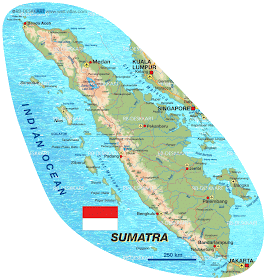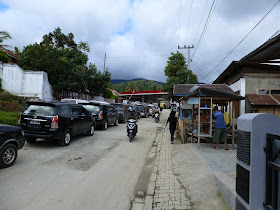 |
| Graphic from Padang Ekspres |
 |
| Map from welt-atlas.de |
This is exactly what happened a couple of days ago. The floods, exacerbated by the longer-than-normal dry season (1), triggered several longsors or mudflows, one of which completely blocked one of the routes to Padang (known locally as the Tapan road). Normally this road is used mainly by truck traffic delivering goods (including gasoline) from Padang in the north and the port at Painan on the west coast. The longsor covered the road, and so for the past few days gasoline has been in short supply. I noticed it first when I went down to Lempur on Saturday: a line of cars and trucks extending for probably 300 meters in either direction from the Pertamina (2) station in south Sungai Penuh. I'd never seen anything like it; the only thing that comes close is pictures of fuel lines in the US in the early 1970s caused by the OPEC oil embargo.
 |
| Traffic snarl caused by line at the Pertamina |
 |
| Pertamina with Pit-bound profiteer in foreground |
The reason I'm writing this post is because I think the road advocates will use the fuel shortage as support for the position that a new road is needed. What better proof could you ask for? It's especially timely since the investigative team I mentioned in the previous post is currently examining the proposed roads. All it takes is one landslide to cripple the economy of the valley; think of all the productive hours lost while civil servants wait in line at the pumps (3). Now imagine what would happen if the local volcano erupted, covering one of the existing roads in lava or lahar while thousands attempted to flee the valley.
But there's another side to the debate. Though it's hard to prove at this point, the longsor that closed the road was most likely due to a) deforestation, b) poor engineering, or c) a combination of the two. I've written previously on how cutting down trees undermines the stability of slopes. Trees have extensive root systems which help to anchor the ground in place. Cut down the trees and you lose the anchors. Trees are especially important in tropical places (like Indonesia) where there is a lot of rain. For some insight into the second possibility, have a look at the picture to the left. I took this photo of a road cut on the way to Lempur last Saturday. Look how steep the slope is. There's no buttressing or anything else to add stability. As you can see, erosion has already started, though the cut is only a year or so old. These types of things are common around here, and the result is pretty predictable. Shear stress eventually exceeds shear strength, and it all comes tumbling down.
So is the answer more roads, or is it more money and better engineering? I don't know the answer to that question, but for the time being it looks like the former is going to win out.
NOTES
(1) When the ground is dry less water is able to infiltrate (seep down into the ground). Once the ground is a little bit moist it is much more permeable. So very dry ground often makes flooding worse.
(2) Pertamina is the state-owned petroleum company; most if not all gas stations in Indonesia are Pertamina stations.
(3)

No comments:
Post a Comment